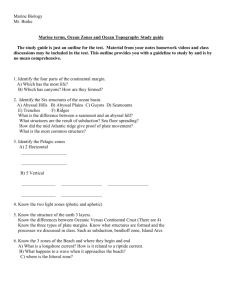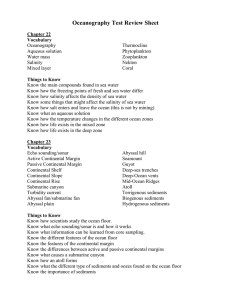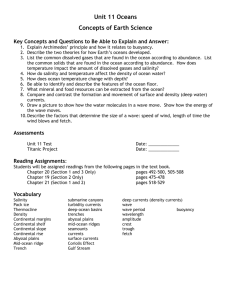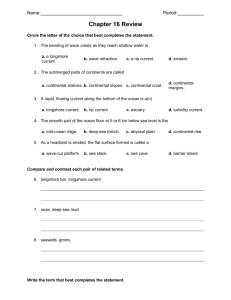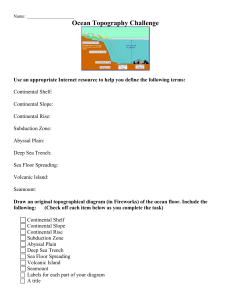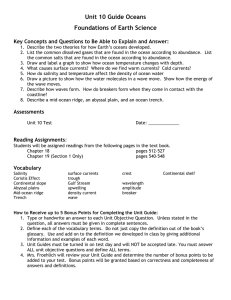Chapter 20 - Coastlines and Ocean Basins.doc
advertisement
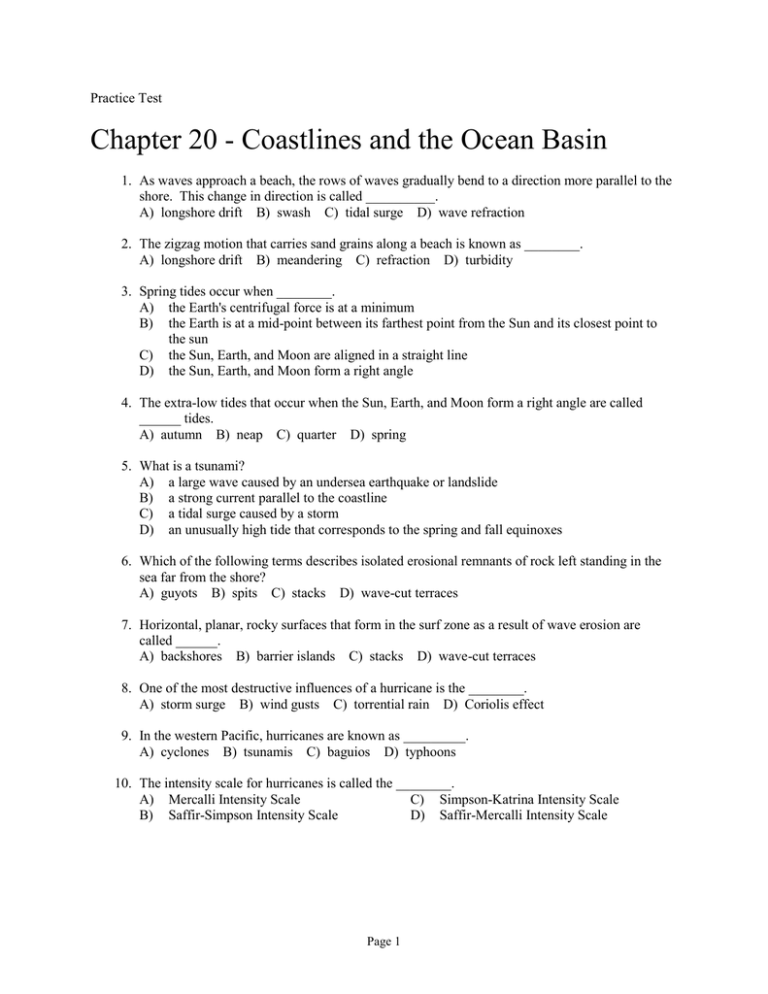
Practice Test Chapter 20 - Coastlines and the Ocean Basin 1. As waves approach a beach, the rows of waves gradually bend to a direction more parallel to the shore. This change in direction is called __________. A) longshore drift B) swash C) tidal surge D) wave refraction 2. The zigzag motion that carries sand grains along a beach is known as ________. A) longshore drift B) meandering C) refraction D) turbidity 3. Spring tides occur when ________. A) the Earth's centrifugal force is at a minimum B) the Earth is at a mid-point between its farthest point from the Sun and its closest point to the sun C) the Sun, Earth, and Moon are aligned in a straight line D) the Sun, Earth, and Moon form a right angle 4. The extra-low tides that occur when the Sun, Earth, and Moon form a right angle are called ______ tides. A) autumn B) neap C) quarter D) spring 5. What is a tsunami? A) a large wave caused by an undersea earthquake or landslide B) a strong current parallel to the coastline C) a tidal surge caused by a storm D) an unusually high tide that corresponds to the spring and fall equinoxes 6. Which of the following terms describes isolated erosional remnants of rock left standing in the sea far from the shore? A) guyots B) spits C) stacks D) wave-cut terraces 7. Horizontal, planar, rocky surfaces that form in the surf zone as a result of wave erosion are called ______. A) backshores B) barrier islands C) stacks D) wave-cut terraces 8. One of the most destructive influences of a hurricane is the ________. A) storm surge B) wind gusts C) torrential rain D) Coriolis effect 9. In the western Pacific, hurricanes are known as _________. A) cyclones B) tsunamis C) baguios D) typhoons 10. The intensity scale for hurricanes is called the ________. A) Mercalli Intensity Scale C) Simpson-Katrina Intensity Scale B) Saffir-Simpson Intensity Scale D) Saffir-Mercalli Intensity Scale Page 1 11. Which of the following regions is a broad, flat, sand- and mud-covered platform that is part of the continent but slightly submerged? A) the abyssal plain C) the continental shelf B) the continental rise D) the continental slope 12. Where is the ocean floor deepest? A) in oceanic trenches B) in submarine canyons C) D) in rift valleys on the abyssal plain 13. How deep is the deepest part of the ocean? A) about 1 kilometer deep B) about 10 kilometers deep C) D) about 3 kilometers deep about 30 kilometers deep 14. Graded beds of sand, silt, and mud deposited on submarine fans are called ______. A) alluvial fans B) dunes C) tills D) turbidites 15. Where does most volcanic activity on the seafloor take place? A) abyssal plains C) continental shelves B) mid-ocean ridges D) oceanic trenches 16. Which of the following is an active continental margin? A) the east coast of Africa C) the east coast of North America B) the west coast of South America D) all of the above 17. Which of the following are flat-topped seamounts, resulting from erosion of an island volcano when it was above sea level? A) guyots B) mesas C) pediments D) stacks 18. Which of the following currents erode and deposit fine-grained sediments on the continental slope and rise? A) longshore currents B) river currents C) tidal currents D) turbidity currents 19. Large fan-shaped deposits of fine-grained sediments that accumulate on the continental rise are called ______. A) alluvial fans B) guyots C) spits D) submarine fans 20. What are foraminifera shells, the most abundant biochemically precipitated pelagic sediment, made of? A) calcium carbonate B) silicon dioxide C) sodium chloride D) iron sulfide 21. Pelagic sediments consist of all of the following except __________. A) calcareous oozes B) quartz sands C) silica oozes D) terrigenous clays 22. The shells of diatoms and radiolaria, which accumulate on the abyssal plain, are composed of ______. A) calcium carbonate B) iron sulfide C) silica D) sodium chloride Page 2 23. The height of an ocean wave increases as ______. A) the distance over which the wind blows over the water decreases B) the wind blows for longer times C) the wind speed decreases D) all of the above 24. What creates ocean waves? A) gravitational forces B) tectonic forces C) solar forces D) wind forces 25. A strong flow of water moving away from the shore at right angles is referred to as a _______. A) swell B) breaker C) rip current D) longshore current Use the following to answer questions 26-27: 26. In the diagram above, the wavelength is the distance __________. A) A-B B) A-C C) A-D D) A-E 27. In the diagram above, where would you expect to find waves of that shape? A) the surf zone B) the deep ocean C) the shoreline D) the abyssal plain 28. What causes the tides? A) earthquakes B) gravity C) ocean currents D) wind Page 3
